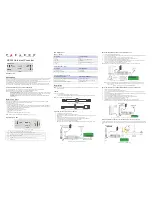
- 5 -
PEDQ 3005/4005/5005 QMX
HF output:
Modulation method: ...................
4, 16, 32, 64, 128, 256 QAM (adjustable)
Symbol rate: ...............................................................
1 … 7 Msymb/sec
Noise voltage ratio: ....................................................................> 42 dB
Output level: ............................................................................. 90 dBμV
Output impedance: ............................................................
75
Ω
, nominal
PEDQ 3005 QMX
Frequency range: .................................................. 112 MHz
…
306 MHz
PEDQ 4005 QMX
Channels: ............................................................................. S21
…
S41
Frequency range: ...................................................306 MHz
…
466 MHz
Channel pattern: ...........................................................................8 MHz
PEDQ 5005 QMX
Channels: ............................................................................ C21
…
C69
Frequency range: ................................................... 474 MHz
…
858 MHz
Channel pattern: ...........................................................................8 MHz
Connections:
Inputs: ..................................................4
DVB-SPI sockets (25-pin, SUB-D)
HF output: ........................................................................... 1 IEC socket
Connection strip (10-pin): ................... For supply voltages and control circuits
Socket RS 232: ......................................... Update interface (in the cassette)
2.3 Description
The cassettes convert up to 4 DVB-SPI data streams in one QAM-modulated
data stream. The cassettes are controlled via the head end station. Each cas-
sette has four
DVB-SPI
inputs and one HF output. Each of the cassettes has
four channel strips ("A", "B", "C", "D") that are indicated in the display of the
control unit with "Bx…A", "Bx…B", "Bx…C" and "Bx…D".
The integrated TP module (TP – Transport Stream Processing) processes the
data from the data streams. It can be used to change service information (NIT
– Network Information Table), select stations / channel strips and increase
the data rates (stuffing). The TP module enables the generation of a new data
stream from up to 4 data streams.
The processed input signals are fed via
t
he HF output to the HF output collector
of the head end station. The output level of the cassettes can be set with the






































